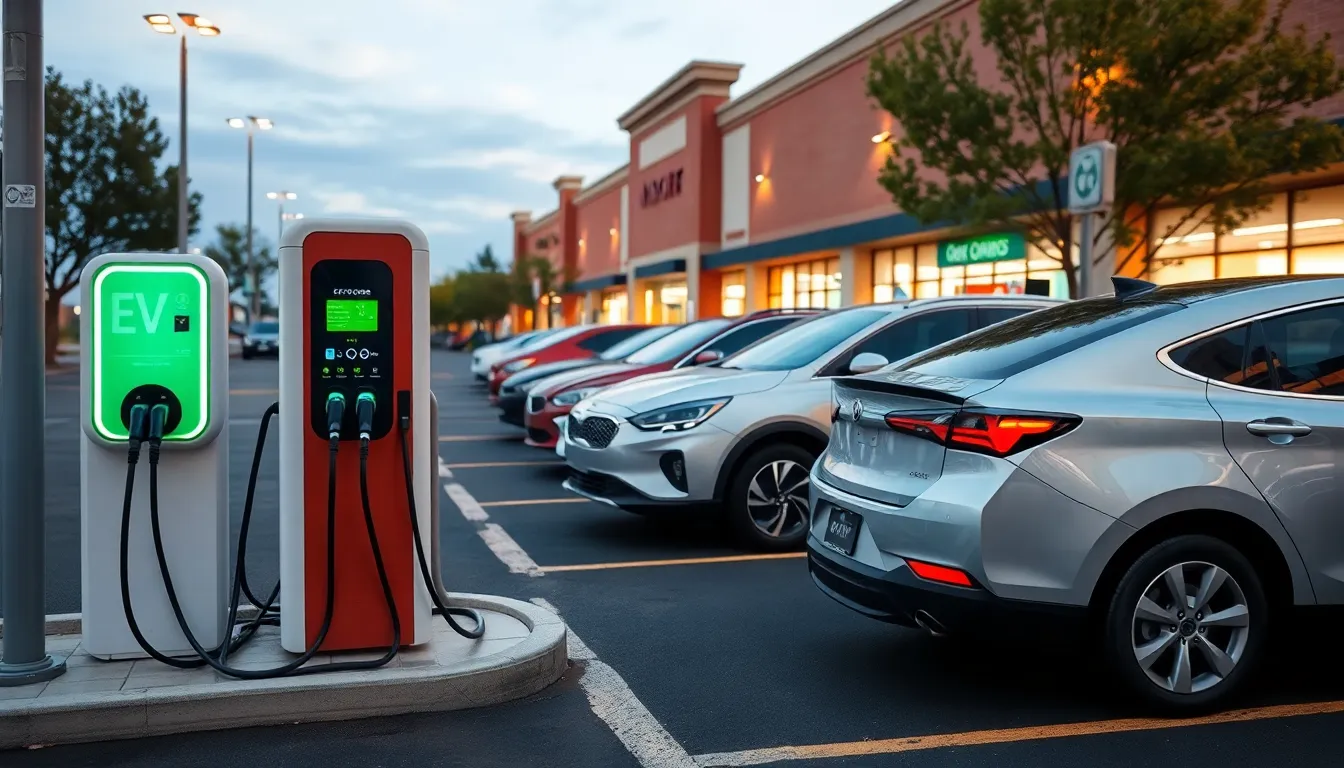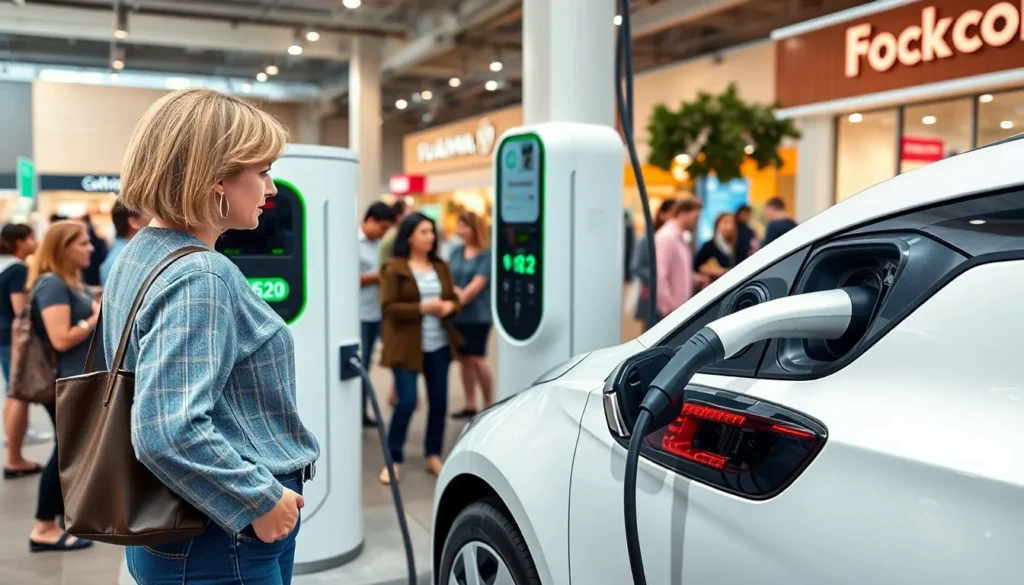Electric vehicles are zooming into the future, but what’s the deal with charging? High-capacity EV chargers are here to save the day, transforming the way drivers think about refueling. Imagine plugging in your car and grabbing a coffee, only to return to a fully charged battery—no more waiting around like you’re at a DMV appointment.
Table of Contents
ToggleOverview of High-Capacity EV Chargers
High-capacity EV chargers significantly enhance the charging process for electric vehicles. These chargers deliver power levels from 150 kW to 350 kW, optimizing the time needed to achieve a full charge. With rapid charging capabilities, many EVs can reach an 80% charge in approximately 30 minutes.
Accessibility is crucial in the deployment of high-capacity chargers. They often appear in public locations, such as shopping centers or highway rest stops, where many drivers can charge their vehicles while taking a break. Increased installation of these chargers supports the growing number of electric vehicles on the road.
Technological advancements play a pivotal role in the performance of high-capacity chargers. These systems utilize advanced cooling technologies that prevent overheating during rapid charging. Enhanced communication protocols enable chargers to interact with vehicles efficiently, adjusting power delivery based on battery needs.
Multiple manufacturers produce high-capacity EV chargers, fueling competition and innovation in the market. Brands such as Tesla, ChargePoint, and Electrify America lead the way, contributing to the development of faster, more reliable charging solutions. Each company’s offerings come with unique features and benefits, catering to diverse user needs.
Understanding the impact of high-capacity EV chargers on the environment becomes increasingly important. By facilitating quicker charging times, these chargers promote more electric vehicle use, ultimately reducing greenhouse gas emissions. Adoption of high-capacity charging infrastructure plays a vital role in achieving sustainability goals.
Investing in high-capacity EV chargers results in long-term benefits for cities and consumers alike. Communities that prioritize these charging solutions can attract more electric vehicle drivers, enhancing the local economy through reduced fuel costs. Emphasizing these innovative technologies fosters a cleaner, more sustainable future for transportation.
Benefits of High-Capacity EV Chargers

High-capacity EV chargers enhance the electric vehicle charging experience significantly. With advanced technology, they offer numerous advantages for users and the environment.
Faster Charging Times
Faster charging times represent a primary benefit of high-capacity EV chargers. Delivering power levels between 150 kW and 350 kW, these chargers enable many electric vehicles to achieve approximately 80% charge within 30 minutes. This efficiency cuts wait times drastically, making it easier for drivers to plan their trips. By minimizing downtime at charging stations, high-capacity chargers support a smoother refueling experience for users.
Increased Convenience for Users
Increased convenience for users is another key advantage. High-capacity chargers are often located in accessible public areas such as shopping centers and highway rest stops. This strategic placement allows electric vehicle drivers to recharge their cars while engaging in other activities, maximizing their time. Moreover, the quick charging capability means users can resume their journeys with minimal interruption. The availability of these efficient charging solutions encourages more drivers to choose electric vehicles, contributing to sustained growth in the EV market.
Types of High-Capacity EV Chargers
High-capacity EV chargers come in various forms, each designed to meet different charging needs. Understanding these types helps users choose the best option for their electric vehicles.
Level 2 Chargers
Level 2 chargers typically provide charging power between 3.3 kW and 22 kW. These chargers use a 240-volt outlet, which allows for faster charging than standard home outlets. Many public charging stations employ Level 2 chargers, making them widely accessible in urban areas. Charging an electric vehicle with a Level 2 charger often results in gaining around 10 to 60 miles of range per hour, depending on the vehicle’s capacity. Users often find Level 2 chargers useful for overnight charging or while parked at workplaces.
DC Fast Chargers
DC fast chargers deliver charging power ranging from 50 kW to 350 kW. This high output allows drivers to charge their vehicles to approximately 80% in just 30 minutes. Many DC fast chargers utilize newer technology, such as liquid cooling, to maintain optimal performance. Locations for these chargers are strategic, often found along highways and in shopping centers. Their rapid charging capabilities significantly reduce downtime for drivers, promoting the practicality of electric vehicle ownership. Access to DC fast chargers encourages longer trips in electric vehicles by alleviating charging time concerns.
Key Features to Consider
High-capacity EV chargers offer several features that directly impact user experience and efficiency. Understanding these aspects can enhance the decision-making process for potential buyers.
Power Output
Power output plays a crucial role in charging speed and overall performance. Chargers range from 150 kW to 350 kW, with higher outputs reducing charging times significantly. For instance, many electric vehicles can achieve up to 80% charge in around 30 minutes when using a 350 kW charger. A higher power output not only benefits individual drivers but also improves charging station throughput, making them more effective at busy locations. Selecting chargers with optimal power ratings ensures a reliable and efficient charging network.
Compatibility with Electric Vehicles
Compatibility with electric vehicles varies among different charger models. Most high-capacity chargers utilize CCS (Combined Charging System) connectors, making them suitable for a wide range of brands, including Tesla, Ford, and Volkswagen. However, some models may offer CHAdeMO connectors, catering to specific vehicle types, primarily from Nissan and Mitsubishi. Understanding vehicle requirements is essential for maximizing charging efficiency. Ensuring a charger’s compatibility with a vehicle model guarantees users a seamless charging experience, ultimately encouraging greater electric vehicle adoption.
High-capacity EV chargers are transforming the electric vehicle landscape by offering faster charging times and increased accessibility. Their strategic placement in public areas makes it easier for drivers to recharge while going about their daily activities. This convenience not only enhances the overall user experience but also encourages more people to make the switch to electric vehicles.
As technology continues to advance and competition in the market grows, these chargers will play a crucial role in promoting sustainable transportation. By supporting the widespread adoption of electric vehicles, high-capacity chargers contribute significantly to reducing greenhouse gas emissions and fostering a cleaner future. The ongoing innovation in this sector promises even greater efficiency and convenience for electric vehicle users in the years to come.





